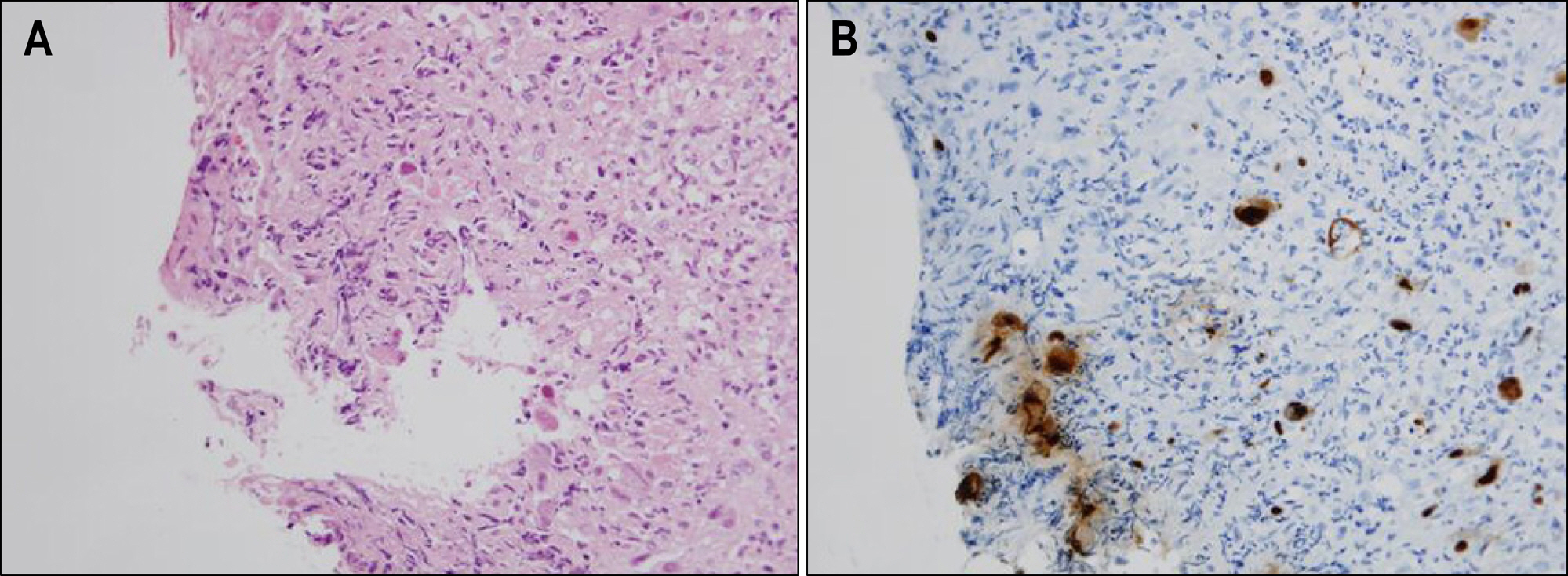Korean J Gastroenterol.
2010 Jan;55(1):62-67. 10.4166/kjg.2010.55.1.62.
Cytomegalovirus Infection-related Spontaneous Intestinal Perforation and Aorto-enteric Fistula after Abdominal Aortic Aneurysmal Repair
- Affiliations
-
- 1Department of Internal Medicine, Konkuk University School of Medicine, Seoul, Korea. sunyoung@kuh.ac.kr
- KMID: 1775928
- DOI: http://doi.org/10.4166/kjg.2010.55.1.62
Abstract
- Gastrointestinal complications (GI) after thoracoabdominal aortic repair can be classified as biliary disease, heptic dysfunction, pancreatitis, GI bleeding, peptic ulcer disease, bowel ischemia, paralytic ileus, and aortoenteric fistula. Theses complications are associated with high post operative morbidity and mortality. Most of the aortoenteric fistulae after thoracoabdominal aortic surgery are found at the duodenum, near the surgical site. These rare complications are caused by an indirect communication with abdominal aorta that originated from an aneursymal formation ruptured into the duodenum. Such aorto-duodenal fistula formation is considered as a result of inflammatory change from secondary infection near the surgical instruments. Herein, we report two cases of massive upper GI bleeding from aorto-duodenal fistulae and spontaneous lower GI perforation related to cytomegalovirus infection after abdominal aortic aneurysmal repair operations.
MeSH Terms
-
Aged
Aged, 80 and over
Aorta, Abdominal/*surgery
Aortic Aneurysm, Abdominal/complications/*surgery
Aortic Diseases/*diagnosis/surgery/virology
Cytomegalovirus Infections/*complications/diagnosis/pathology
Endoscopy, Gastrointestinal
Gastrointestinal Hemorrhage/etiology
Humans
Intestinal Fistula/*diagnosis/surgery/virology
Intestinal Perforation/*diagnosis/virology
Male
Vascular Fistula/*diagnosis/surgery/virology
Figure
Reference
-
1. Achouh PE, Madsen K, Miller CC 3rd, et al. Gastrointestinal complications after descending thoracic and thoracoabdominal aortic repairs: a 14-year experience. J Vas Surg. 2006; 44:442–446.
Article2. Valentine RJ, Hagino RT, Jackson MR, Kakish HB, Bengtson TD, Clagett GP. Gastrointestinal complications after aortic surgery. J Vasc Surg. 1998; 28:404–411.
Article3. Durrani NK, Trisal V, Mittal V, Hans SS. Gastrointestinal complications after ruptured aortic aneurysm repair. Am Surg. 2003; 69:330–333.4. Bjorck M, Bergqvist D, Troëng T. Incidence and clinical presentation of bowel ischaemia after aortoiliac surgery - 2930 operations from a population-based registry in Sweden. Eur J Vasc Endovasc Surg. 1996; 12:139–144.5. Neary P, Hurson C, Briain DO, et al. Abdominal aortic aneurysm repair and colonic infarction: a risk factor appraisal. Colorectal Dis. 2007; 9:166–172.
Article6. Hinchliffe RJ, Armon MP, Tse CC, Wenham PW, Hopkinson BR. Colonic infarction following endovascular AAA repair: a multifactorial complication. J Endovasc Ther. 2002; 9:554–548.
Article7. Kim MW, Hundahl SA, Dang CR, McNamara JJ, Straehley CJ, Whelan TJ Jr. Ischemic colitis after aortic aneurysmectomy. Am J Surg. 1983; 145:392–394.
Article8. Kim CJ, Kim YW, Joh JH, Leem HI, Kim DI, Huh S. Lessons from successful surgical treatment of aortoenteric fistula. J Korean Soc Vasc Surg. 2005; 21:16–22.9. Lemos DW, Raffetto JD, Moore TC, Menzoian JO. Primary aortoduodenal fistula: a case report and review of the literature. J Vasc Surg. 2003; 37:686–689.
Article10. Nyberg A, Skagius E, Nilsson I, Ljungh A, Henriksson AE. Abdominal aortic aneurysm and cytomegalovirus infection. J Med Virol. 2008; 80:667–669.
Article11. Bastounis E, Papalambros E, Mermingas V, Maltezos C, Dia-mantis T, Balas P. Secondary aortoduodenal fistulae. J Cardiovasc Surg. 1997; 38:457–464.12. Vollmar JF, Kogel H. Aortoenteric fistulas as postoperative complication. J Cardiovasc Surg. 1987; 28:479–484.13. Constans J, Midy D, Baste JC, Demortiere F, Conri C. Secondary aortoduodenal fistulas: report of 7 cases. Rev Med Interne. 1999; 20:121–127.14. Capaldo GR, Amin RM. Aortoduodenal fistula. Two case reports and a review of the literature. J Cardiovasc Surg. 1996; 37:567–570.15. Mark AS, Moss AA, McCarthy S, McCowin M. CT of aortoenteric fistulas. Invest Radiol. 1985; 20:272–275.
Article16. Sweeney MS, Gadacz TR. Primary aortoduodenal fistula: manifestation, diagnosis and treatment. Surgery. 1984; 96:492–497.17. Goodgame RW. Gastrointestinal cytomegalovirus disease. Ann Intern Med. 1993; 119:924–935.
Article18. Hinnant KL, Rotterdam HZ, Bell ET, Tapper ML. Cytomegalovirus infection of the alimentary tract: a clinicopathological correlation. Am J Gastroenterol. 1986; 81:944–950.19. Roberts WH, Sneddon JM, Waldman J, Stephens RE. Cytomegalovirus infection of gastrointestinal endothelium demonstrated by simultaneous nucleic acid hybridization and immunohistochemistry. Arch Pathol Lab Med. 1989; 113:461–464.20. Surawicz CM, Myerson D. Self-limited cytomegalovirus colitis in immunocompetent individuals. Gastroenterology. 1998; 94:194–199.
Article
- Full Text Links
- Actions
-
Cited
- CITED
-
- Close
- Share
- Similar articles
-
- Entero-colonic Fistula Secondary to Necrotizing Enterocolitis in Premature Infant: A Case Report
- A case of aorto-colonic fistula due to aortic pseudoaneurysm presented by massive gastrointestinal bleeding
- Lessons from Successful Surgical Treatment of Aortoenteric Fistula
- Cervical Epidural Abscess Secondary to Aorto-Duodenal Fistula: A Case Report
- Spontaneous Rupture of Aortoiliac Aneurysm into Left Common Iliac Vein Combined with Gastric Leiomyoma: A case report






